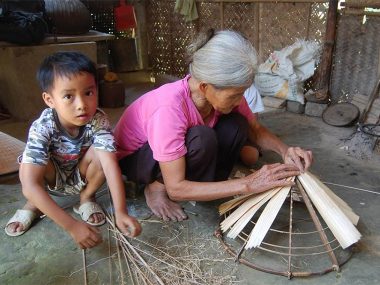Vietnamese non la hat

 The non la palm hat (nón lá) is one of the symbols of Vietnam. Non la is very popular in modern Vietnam, and the streets are full of people wearing this hat. The women working in the tourism wear it in addition to the traditional ao dai dress, as well as ordinary residents of Vietnamese cities and villages. That’s understandable. After all, non la hat protects perfectly from the sun and rain. It can also serve as a basket or a plate for farmers working in the field. Hats are worn by villagers working in the rice fields, housewives riding their bicycles going shopping, fishermen, sellers and many other people who need to protect themselves from the sun and bad weather.
The non la palm hat (nón lá) is one of the symbols of Vietnam. Non la is very popular in modern Vietnam, and the streets are full of people wearing this hat. The women working in the tourism wear it in addition to the traditional ao dai dress, as well as ordinary residents of Vietnamese cities and villages. That’s understandable. After all, non la hat protects perfectly from the sun and rain. It can also serve as a basket or a plate for farmers working in the field. Hats are worn by villagers working in the rice fields, housewives riding their bicycles going shopping, fishermen, sellers and many other people who need to protect themselves from the sun and bad weather.
History of Vietnamese non la hat
The Vietnamese non la hat is at least 3000 years old. Images of the non la are evident on the bronze cylindrical jar of Dao Thinh and Ngoc Lu bronze drum. Of course, the appearance of the hat and the technology of its manufacture have changed over such a significant period of time. For example, when there were no tools for sewing, the headdress was knitted. In the Iron age the needle was invented and it began to be used for sewing non la hats. At different times, there were more than 50 types of hats: for children and adults, soldiers, monks, and even a special variety for people in mourning.
An ancient legend tells how the hat appeared. A long time ago it was raining and the rain didn’t stop for days. Then the goddess descended from heaven, who took pity on people. She was wearing a hat of palm leaves tied with bamboo sticks. The goddess was floating over the people, protecting them from the rain. One day the people after waking up saw that the rain was over, and the goddess returned to heaven. Masters decided to make a hat that could always protect them from rain or sun.
How to make a non la hat
 To make a hat, you need Sabal palm tree leaves. In addition, the master use elastic nylon threads to make a hat (in ancient times, the threads made of fibers of forest plants were used) as well as bamboo for hoop and frame.
To make a hat, you need Sabal palm tree leaves. In addition, the master use elastic nylon threads to make a hat (in ancient times, the threads made of fibers of forest plants were used) as well as bamboo for hoop and frame.
Palm leaves are gathered and ironed on a hot iron sheet. When Ironing, it is necessary to adjust the temperature with precision. High temperature makes the leaves fragile and yellow. Low temperature makes the palm leaves smooth only for a while. Further, to whiten the leaves and protect them from the mold and damage by insects, they are kept over a fire of burning sulfur.
The hat can have different number of hoops. For example, in the village of Chuong near Hanoi the masters make a frame of 16 hoops. A skillful master always hides the connection nodes of the thread when sewing, so you can’t see them. The hat usually comes with a ribbon that is tied under the chin, to hold this light headdress firmly on the head.
How to decorate Vietnamese non la hats
Sometimes non la hats are decorated with patterns, images or even calligraphy poems. Even in the most ordinary tourist shops you can find non la hats embroidered with bright threads. Sometimes girls fasten a tiny mirror from the inside of a hat to look in if they need. Vietnamese believe that under the hat the eyes, smile and white skin of a beautiful girl seem mysterious and even more charming.
Of course, the Vietnamese non la hat is a great souvenir. Markets and shops offer hats of different sizes, from standard headgear to the smallest hats that can be hung on the wall or used to have some fun with your pet. You can buy several hats and put them one in another to spot them from bending or breaking. You get a pretty strong construction, and can also make several friends and relatives happy with a gift from Vietnam. Also, these hats are quite inexpensive. In the gift shop a non la hat with embroidery will cost you $ 2, and if you find a Vietnamese market with no tourists (the markets for tourists have higher prices), buy a real non la hat for $ 0.5.
More about culture of Vietnam Calculate tour to Vietnam








